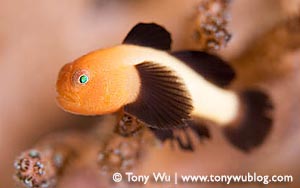 It’s been about a month since I returned from my latest trip to the Lembeh Strait. Since then, I’ve had to travel for non-diving stuff, and I haven’t had much time to go through photos or collect my thoughts. This weekend, I made a concerted effort to catch up, so here’s a belated trip report:
It’s been about a month since I returned from my latest trip to the Lembeh Strait. Since then, I’ve had to travel for non-diving stuff, and I haven’t had much time to go through photos or collect my thoughts. This weekend, I made a concerted effort to catch up, so here’s a belated trip report:
On Being Original
One of the most difficult things about going some place as popular as the Lembeh Strait is being original. There are so many people visiting Lembeh these days, and the underwater topography is so easily recognisable, that many (arguably most) of the photographs from the area look the same.
I realise this is a gross generalisation, but it’s really not overly difficult to spot a photograph from Lembeh, and to be honest, many of the images I see from the area (from amateurs and professionals alike) are simply boring…not necessarily because they’re poor images, but because I’ve seen so many similar photographs before. Ho hum.
So the theme of my recent trip, if there was one, was to dedicate my efforts to being as original as possible…to create unique images. Not that this isn’t normally at the top of my list of priorities, but I did take some extra steps to force myself into following the Apple Computer motto: “Think Different”.
Painting with Light
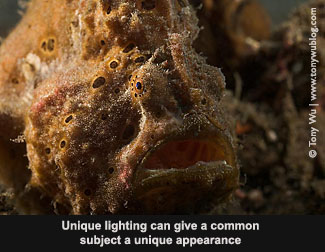 First, recall that the word “photography” derives from two Greek root words: phos, which means light, and graphos, which means writing (Ah, my high-school classics teachers would be so proud of me).
First, recall that the word “photography” derives from two Greek root words: phos, which means light, and graphos, which means writing (Ah, my high-school classics teachers would be so proud of me).
To apply a bit of liberal translation then, photography is the art of writing with light. Actually I prefer to think of it as “painting with light”.
Lighting is something that land-bound photographers take very seriously and spend a lot of time considering. Have you ever, for instance, watched a studio photo shoot? There are main lights, secondary lights, bounce lights, diffused light, lights of different colour temperatures, etc.
All too often in underwater photography, lighting is just one or two strobes of the same type pointed straight on, or at best slightly angled away from, the main subject.
In most circumstances, this regimented approach produces usable images. Arguably, however, the same old approach produces images that almost always look, well…the same.
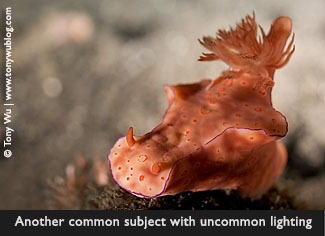 So one of the things I decided prior to hitting the water was to avoid shooting photos with the standard strobe set-up.
So one of the things I decided prior to hitting the water was to avoid shooting photos with the standard strobe set-up.
Over the years, I’ve experimented enough with lighting to know roughly what works and what doesn’t (The cover of my book Silent Symphony was one of my earliest lighting experiments, a technique which took nearly three years to perfect.), but this time, I forced myself to try really outlandish stuff, some of which worked, some of which didn’t.
When the new ideas worked, I got unique images. When they didn’t, I got diddly (that’s the technical term for “nothing”). Such, I guess, is the nature of experimentation. Sometimes you succeed; most of the time you flub up (that’s the technical term for “engaging in the act of producing nothing”).
Each time an idea flopped though, I came up with three or four more new ideas based upon the one that just fell through. In fact, though I struggled in the first couple of days to dream up imaginative lighting concepts, by the end of the trip, I had more potential ideas to test than I realistically had time for. There's so much more to try on the next trip…
Exploring all the Angles
 Something else I did to change things up was to disallow myself from using standard lenses.
Something else I did to change things up was to disallow myself from using standard lenses.
What does this mean? Think of it this way: What percentage of photographs from Lembeh (taken with an SLR) are taken with Nikon 105mm and 60mm macro lenses (or their counterparts from other manufacturers)?
Of course, without conducting a rigorous survey, it’s impossible to know for certain. But based upon personal observation, I’d say it’s a vast majority.
Again, there’s absolutely nothing wrong with these lenses. In fact, they’re wonderful lenses. But just as using the same lighting set-up on every dive produces images that seem like Xerox copies of other images, so using the same lenses as everyone else tends to result in images that look alike.
In practical terms, I made myself go to extremes, alternating between a variety of wide-angle and extreme macro set-ups.
 Doing this forced me to look at dive sites and potential photo subjects differently. There are, after all, a limited number of sites in Lembeh. Seeing them and their resident marine life from a unique perspective is one way to avoid monotonous photography.
Doing this forced me to look at dive sites and potential photo subjects differently. There are, after all, a limited number of sites in Lembeh. Seeing them and their resident marine life from a unique perspective is one way to avoid monotonous photography.
Of course, that’s not to say that I didn’t use normal lenses at all, but I only did so when I needed to give my eyes and mind a break (It’s not easy focusing at 4-5x life-size magnification, or waiting forever for everything to line up perfectly for wide-angle scenes).
And what I found was that by limiting my dives with “normal” lenses to one every two days or so, I enjoyed those dives a lot more than I probably normally would have, and I was better able to be creative with standard lenses.
The Advantage of Apathy
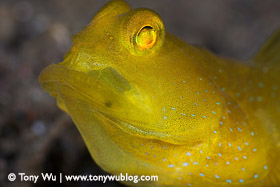 There’s a trick I stumbled upon some time ago which has served me quite well.
There’s a trick I stumbled upon some time ago which has served me quite well.
Many people become anxious when they hit the water. There are any number of reasons for this, but for underwater photographers, there’s often a self-inflicted pressure to take as many photos as possible, of as many things as possible, as quickly as possible.
Maybe you don’t suffer from this tendency, but that’s the natural impulse I’ve always had.
Some years ago, I discovered that being apathetic makes for better images. Ok, perhaps I’m overstating the case here, but what I mean is that by going into the water thinking: “It doesn’t matter if I get any photos at all. Whatever I see, I see. If I don’t see anything, no big deal. If I see something, I really want to see it first, before taking any photos.” you significantly increase your chances of coming out with awesome photographic results.
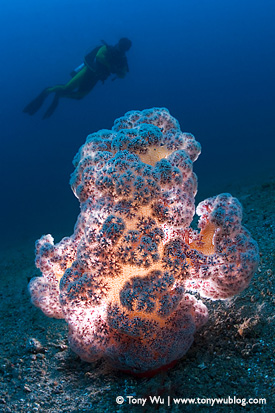 Seems counterintuitive, doesn’t it?
Seems counterintuitive, doesn’t it?
All I can say is that since I’ve come to this realisation, the quality of my images has improved dramatically. This trip was no exception. I had my fair share of camera difficulties, equipment problems, seemingly dull dives, etc., but with my “apathetic” approach, I managed to find incredibly interesting things on every dive, to observe fascinating behaviour, and to pull some stunning photos out of the proverbial hat, when all good sense suggested no photos would be forthcoming.
I have no logical explanation for why this works, and by no means am I suggesting that you should be truly apathetic about the marine environment, your photography or anything else.
I suppose the advantage of being “apathetic” in this controlled manner, is that you spend a lot more time with your eyes and mind open, and the ocean responds accordingly.
People and Places
My host for the trip was Kasawari Lembeh Resort, which I wrote about in an earlier blog post. The facilities have been designed with photographers and videographers in mind, so if you have significant camera gear and plan to visit the Strait, check out this new resort. I love it there…for the photo-oriented facilities, the spacious rooms and all the wonderful staff, who’ve become good friends.
 I had many friends from Thailand and Japan rendezvous with me on this trip, which was particularly nice. I’m perfectly fine hanging out and diving alone, but having familiar faces around doesn’t hurt, especially for extended stays.
I had many friends from Thailand and Japan rendezvous with me on this trip, which was particularly nice. I’m perfectly fine hanging out and diving alone, but having familiar faces around doesn’t hurt, especially for extended stays.
As with other trips, I also made new friends, including a group of ten really fun people from the US, who all work for a major pharmaceutical company. It was fun joking around with them (at one stage, I convinced a few of them that rambutans set out for dessert were chilled sea urchins!), and also harassing them with questions about the pharmaceutical industry. There's no better way to learn about something than directly from first-hand sources.
Also, I met three Singaporeans who live and work in Hong Kong: Alvin, Chong Chui and Peter (I lost the piece of paper that I wrote your names on. If I remembered your names incorrectly, please let me know.)
 Now here’s the amazing thing: This trio planned their trip based upon my last blog post about North Sulawesi. They followed the same itinerary, stayed at the same places I did, and ended up at Kasawari for an overlap of a few days with me.
Now here’s the amazing thing: This trio planned their trip based upon my last blog post about North Sulawesi. They followed the same itinerary, stayed at the same places I did, and ended up at Kasawari for an overlap of a few days with me.
Whoa. Someone actually listened to what I said?
Of course, now that we’ve met in person, they’ve no doubt wised up and won’t be making that kind of mistake again in the near future. 😊
I’d also like to say thanks to some people who never get the attention they deserve…the dive guides. I was chatting with one of the owners of the resort one day, and somehow we got on the topic of famous photographers and dive guides.
So many photographers from around the world have visited Lembeh and become well known with the help of local dive guides. The photographers return home and go on to receive awards, international acclaim, etc., while the dive guides rarely get anything of the sort.
The guides at Kasawari are first rate, and they (along with their counterparts at other resorts and liveaboards) are the unsung heroes of the diving community in Lembeh.
Without them, most visitors (including world-renowned photographers) wouldn’t find half the stuff they end up seeing, not to mention the fact that the guides go to great lengths to ensure your safety every time you get in and out of the water. Next time you go on a dive trip, consider saying an extra “Thank you”.

Wrapping Up
Quite often after I put up a blog post like this, I get emails asking what cameras, lenses, strobes, settings to use to reproduce the look of one of my photographs.
I suppose the bottom line for being original is this: Don’t ask me (or anyone else for that matter) how to be original. It defeats the purpose.
If you’re new to underwater photography, or you don’t get a lot of time to dive, stick to the basics until you can get usable shots without even thinking about it. Then you can, and should, experiment.
If you consider yourself a photo veteran, consider this: when’s the last time you tried something for the first time?
As usual, there are many more photos from the trip I haven’t had time to go through yet. Check my Flickr page from time to time for more images, and if you haven’t seen the slideshow/ video of Harry the Frogfish yet, please take a look. The images are from this trip to Lembeh, and the story is entertaining.